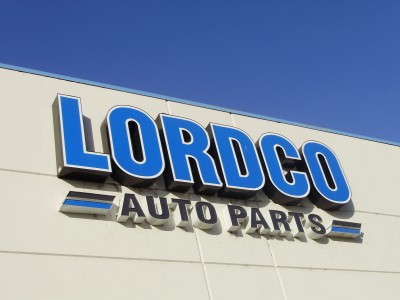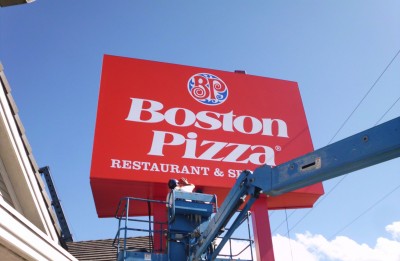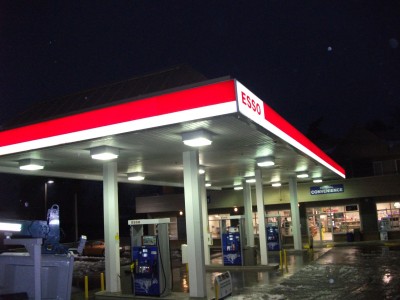Sign Shop Profile: Landmark Sign
by all | 10 February 2014 8:30 am
 [1]
[1]Dave Cunningham (left) and Ryan Shepherd (right) are the business partners behind Landmark’s success. Photos courtesy Landmark Sign
By Peter Saunders
When Dave Cunningham founded Landmark Sign in Victoria in 1997, it was a one-man operation based in an 83.6-m2 (900-sf) two-storey garage. Today, Landmark has become the largest illuminated sign manufacturer on Vancouver Island and a major contender in the Canadian sign industry.
Humble beginnings
Cunningham’s early experiences in the sign industry prepared him to start up a ‘backyard business’ of his own.
“I started working for a local sign company after I finished high school in the mid-1980s and really enjoyed it,” says Cunningham. “I ended up staying there for about 12 years before leaving and renting my dad’s garage to start my business.”
He assembled all of the sign fabrication equipment he needed to get started, including some machines he had already bought and a new crane truck. He set up his shop for a wide range of specialized work, including neon tube bending.
 [2]
[2]The shop’s first corporate client was Lordco Auto Parts. Within a few years, Landmark took over all of its sign business.
“I flew by myself from late 1997 until mid-1998, when I hired my first employee, and then soon hired another,” he says. “There were the three of us working in that garage for about two years.”
By then, Cunningham had already landed his first corporate client, Lordco Auto Parts. He began manufacturing and installing all types of illuminated and non-illuminated signage for Lordco locations throughout the province. One of the most eye-catching was a pylon sign in the shape of a giant piston, installed at the chain’s Victoria shop. Within a few years, Landmark took over all of Lordco’s sign business.
“Soon we were running out of room in the garage and had to paint signs out on the driveway, so I started looking at leasing a shop,” says Cunningham, “When I found the one we have now, with nearly 1,115 m2 (12,000 sf) of space on two storeys, it was available for sale, not for lease, but it was cheap, as this was during a recession. So, I sold my house to buy it and we moved there in late 2000.”
Cunningham renovated the shop for Landmark’s use, turning it into a full-fledged manufacturing facility. As the company was still growing to fill the space, he was able to rent out the lower floor for the first two years.
“I had hoped to fill it,” he explains, “and we did, after those first few years.”
More corporate clients followed, including Iris Optical, first in British Columbia and then across
Canada. Meanwhile, a large local sign company was bought out in the early 2000s by new owners in Vancouver, who decided to close down its operations in Victoria. This created a significant market opportunity for Landmark.
 [3]
[3]Having started as a garage-based business, Landmark has grown to become the largest illuminated sign manufacturer on Vancouver Island.
“Over the next few years, we hired 10 people who came from other local sign companies,” says Cunningham. “These were some really skilled individuals, with years of experience. One of them, Richard Jennings, is still our shop foreman today.”
A new partnership
In 2009, Ryan Shepherd joined Landmark as a partner. He had a very different background.
“I knew Ryan from other business and banking ventures,” Cunningham says, “and when he was working on his own, I hired him as a consultant to help Landmark become more profitable. We butted heads on some issues, but he really got us going.”
Shepherd’s background in business consulting brought additional, different perspectives to the company.
“When I had started consulting with Landmark in the early 2000s, it was a decent shop,” says Shepherd, “but we acquired more equipment, including a computerized paint system, a large computer numerical control (CNC) router, a paint booth large enough to accommodate a semi-trailer truck. Soon, we also added more installation vehicles, including a 23.5-m (77-ft) crane truck and a 18.3-m (60-ft) bucket truck.”
These investments helped position Landmark for growth well beyond its existing client base.
 [4]
[4]Landmark handles its own sign installations and service locally and throughout central British Columbia.
“After targeting local businesses, we hired new, experienced sales representatives to help expand our base of corporate customers,” Shepherd says. “As we built our team and concentrated on ensuring efficient service, we divided Landmark into two divisions for local and national clientele.”
Today, Shepherd is Landmark’s general manager, overseeing some 23 employees working with new sign fabrication equipment and trucks.
“In the past, I did everything,” says Cunningham, including sales, artwork, fabrication, permit applications and installations. Now, Ryan manages the day-to-day operations as I focus on new business endeavours.”
One-stop shop
Landmark has manufactured all types of signs, illuminated and non-illuminated, as it pursues larger and larger jobs—and has added new equipment as required—but primarily focuses its efforts on large-scale illuminated signs and custom work.
“It’s all hand fabrication work, such as channel letter bending,” Cunningham explains. “We try to do everything in-house.”
 [5]
[5]In the past few years, Landmark has comprised two divisions, with one serving local customers and the other focusing on national clients.
“We rarely ever have to outsource sign fabrication, except waterjet cutting once in a blue moon or major structural projects that require the bending of thick tubing,” adds Shepherd. “That all represents less than five per cent of our work. A lot of other sign shops subcontract work out, which is sometimes cheaper, but then you have no quality control. Our ability to handle almost anything in-house is one of the main reasons some of our corporate clients choose to work with us.”
Today, Landmark’s major clients still include Lordco and Iris Optical, along with newer customers like Wok Box and Telus.
“We became the biggest sign company on Vancouver Island partly because of our speed and efficiency and partly because we were very aggressive about sales,” says Shepherd.
Landmark now has enough resources to handle its own sign installations locally and throughout central British Columbia, but subcontracts the work to other installers throughout Canada when serving more distant customers.
“We’re not relying only on the local economy,” Cunningham says. “We have streamlined our shipping deals for a wider territory and we have built a reliable network of subcontractor installers throughout the years. We have also built relationship with permit departments across Canada. We’re like an assembly line now, always moving stuff out.”
 [6]
[6]Landmark’s newer major clients include Telus and Wok Box.
“We’re still a major competitor in Victoria, but ideally, we want to keep growing as a one-stop shop both locally and nationally,” says Shepherd. “We’ve established new sales reps to work with accounts across Canada. We want a balance, so if the local market becomes quiet, we have work all over the country to pick up the slack.”
Given the past few years of business growth, it should be no wonder Landmark is ready to move to yet another facility.
“We’re really out of space again and are currently looking for a larger facility that would meet our needs,” says Cunningham. “If we had a 1,858-m2 (20,000-sf) warehouse all on one level, with a mezzanine and offices in front, it would be perfect.”
For more information, visit www.landmarksign.net[7].
- [Image]: http://www.signmedia.ca/wp-content/uploads/2014/02/daveryan-landmark-002.jpg
- [Image]: http://www.signmedia.ca/wp-content/uploads/2014/02/P3230115.jpg
- [Image]: http://www.signmedia.ca/wp-content/uploads/2014/02/Work-mar-26-002.jpg
- [Image]: http://www.signmedia.ca/wp-content/uploads/2014/02/2-BOSTON-PIZZA-014-Copy.jpg
- [Image]: http://www.signmedia.ca/wp-content/uploads/2014/02/Esso-Teminal-1-Copy.jpg
- [Image]: http://www.signmedia.ca/wp-content/uploads/2014/02/Telus-victoria-business-centre-3-Copy.jpg
- www.landmarksign.net: http://www.landmarksign.net
Source URL: https://www.signmedia.ca/profile-landmark-sign/